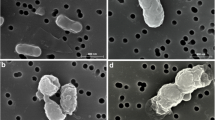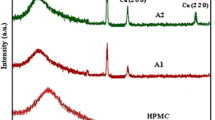Abstract
This study was designated to determine the antimicrobial effect of ethyl-N-α-dodecanoyl-l-arginate hydrochloride (LAE) incorporated into ethylene vinyl alcohol copolymers (EVOH) films on chicken stock and ready-to-eat surimi sticks. Firstly, the effect of LAE against Listeria monocytogenes and Escherichia coli was studied by using flow cytometry and scanning electron microscopy. Next, film-forming solutions of ethylene vinyl alcohol copolymers EVOH29 and EVOH44 (29 and 44 % molar percentage of ethylene, respectively) containing 0, 5 and 10 % w/w of LAE were cast into films. Several experiments were conducted to determine the antimicrobial activity of the films in vitro and also in vivo with the above-mentioned food products. The outcome of the tests showed a high impact on the viability of bacteria treated with LAE, with dramatic damage to the membrane. The films were able to inhibit the microbiota of the food products studied for 10 days under storage at 4 °C, showing a significant antibacterial effect against L. monocytogenes and E. coli. These films show great potential as systems for sustained release of active molecules to improve the safety and quality of packaged food products.


Similar content being viewed by others
References
Adams MR & Moss MO (2008) Food microbiology. The Royal Society of Chemistry Cambrigde, UK
Appendini, P., & Hotchkiss, J. H. (2002). Review of antimicrobial food packaging. Innovative Food Science and Emerging Technologies, 3(2), 113–126.
Bakal G & Diaz A (2005) The lowdown on lauric arginate. Food quality(Feb./March), 60-61.
Fellows PJ (2009) Food processing technology: principle and practice. Third edn.
Guo, M., Jin, T., Wang, L., Scullen, O. J., & Sommers, C. (2014). Antimicrobial films and coatings for inactivation of Listeria innocua on ready-to-eat deli turkey meat. Food Control, 40, 64–70.
Han JH (2013) Innovations in food packaging.
Hawkins, D. R., Rocabayera, X., Ruckman, S., Segret, R., & Shaw, D. (2009). Metabolism and pharmacokinetics of ethyl N-alpha-lauroyl-L-arginate hydrochloride in human volunteers. Food and Chemical Toxicology, 47(11), 2711–2715.
Higueras, L., Lopez Carballo, G., Hernandez Munoz, P., Gavara, R., Rollini, M., López Carballo, G., & Hernández Muñoz, P. (2013). Development of a novel antimicrobial film based on chitosan with LAE (ethyl-N)-dodecanoyl-l-arginate) and its application to fresh chicken. International Journal of Food Microbiology, 165(3), 339–345.
Kilcast D & Subramaniam P (2000) The stability and shelf-life of food. Woodhead Publishing Cambridge
Muriel-Galet, V., Lopez-Carballo, G., Gavara, R., & Hernandez-Munoz, P. (2012). Antimicrobial food packaging film based on the release of LAE from EVOH. International Journal of Food Microbiology, 157(2), 239–244.
Muriel-Galet, V., López-Carballo, G., Hernández-Muñoz, P., & Gavara, R. (2013). Characterization of ethylene-vinyl alcohol copolymer containing lauril arginate (LAE) as material for active antimicrobial food packaging. Food Packaging and Shelf Life, 1, 10–17.
Rodriguez, E., Seguer, J., Rocabayera, X., & Manresa, A. (2004). Cellular effects of monohydrochloride of L-arginine, N-alpha-lauroyl ethylester (LAE) on exposure to Salmonella typhimurium and Staphylococcus aureus. Journal of Applied Microbiology, 96(5), 903–912.
Sallam, & Ibrahim, K. (2007). Antimicrobial and antioxidant effects of sodium acetate, sodium lactate, and sodium citrate in refrigerated sliced salmon. Food Control, 18(5), 566–575.
Sung, S.-Y., Sin, L. T., Tee, T.-T., Bee, S.-T., Rahmat, A. R., Rahman, W. A. W. A., Tan, A.-C., & Vikhraman, M. (2013). Antimicrobial agents for food packaging applications. Trends in Food Science & Technology, 33(2), 110–123.
Theinsathid, P., Visessanguan, W., Kruenate, J., Kingcha, Y., & Keeratipibul, S. (2012). Antimicrobial activity of lauric arginate-coated polylactic acid films against Listeria monocytogenes and Salmonella typhimurium on cooked sliced ham. Journal of Food Science, 77(2), M142–149.
Acknowledgments
The authors acknowledge the financial support of the Spanish Ministry of Economy and Competitiveness, project AGL2012-39920-C03-01, and fellowship funding for V. M.-G.
Author information
Authors and Affiliations
Corresponding author
Rights and permissions
About this article
Cite this article
Muriel-Galet, V., López-Carballo, G., Gavara, R. et al. Antimicrobial Effectiveness of Lauroyl Arginate Incorporated into Ethylene Vinyl Alcohol Copolymers to Extend the Shelf-Life of Chicken Stock and Surimi Sticks. Food Bioprocess Technol 8, 208–217 (2015). https://doi.org/10.1007/s11947-014-1391-x
Received:
Accepted:
Published:
Issue Date:
DOI: https://doi.org/10.1007/s11947-014-1391-x




